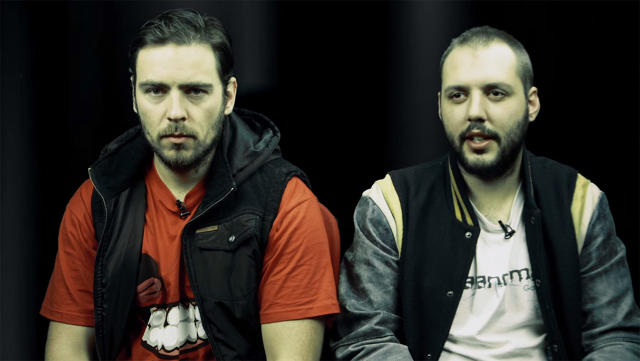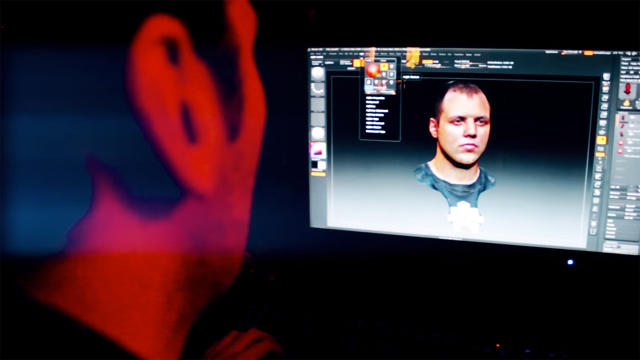Imagine that you could see your late grandmother again. Or your mother who passed away from cancer. Or your brother who died in a car accident. The longing to reconnect with the people we’ve lost is as basic as breathing, so it's no surprise that designers and engineers have started exploring how we deal with death, and, as part of that bottomless topic, how to technologically reinvigorate the departed. This is the current endeavor of Nick Stavrou and Steve Koutsouliotas, two best friends who both lost their fathers unexpectedly and later co-founded the gaming company Paranormal Games. Today, they are developing a demo for —a personalized experience in which users can visit with 3-D models of the dead in a virtual reality setting.
The very notion of virtual reanimation seems fraught, to say the least. While literature and film have explored the horrific side of life-after-death misadventures, modern attempts to revisit the departed seem destined to end, simply, in more heartache. The creators of Project Elysium are careful to keep their proposal grounded in reality, and in helping the bereaved. "We’re giving people the opportunity to spend time with their loved ones in a custom-made, private and scripted virtual environment," says Stavrou. "It’s a therapeutic experience aimed to help the people left behind work through their grief."
THE DANGERS OF VISITING THE DEAD
You may have seen the breakout British series Black Mirror and the episode, "Be Right Back," in which a woman loses her husband in a car accident and, unable to move on, buys an artificially engineered version of him: a breathing, life-like being whose mind and speech is populated by all the details of his digital footprint. In short, his emails, texts, videos, and photographs allow the stand-in husband to speak, sound, think, and behave almost exactly like the living version of himself. In the end, however, the stand-in husband isn’t quite real enough to satisfy the grieving wife—and yet he’s too real to give up. It’s a disturbing paradox and one that clearly demonstrates the pitfalls of trying to re-engineer the natural cycle of life and death.
Stavrou and Koutsouliotas haven’t seen Black Mirror and don’t plan to; they don’t want outside influences to corrupt their vision. But they do say Project Elysium isn’t about recreating an absolutely "real" version of the deceased. The world they’re creating is not intended to be a kind of Second Life for the dead. It’s meant to be what Stavrou calls a "virtual sanctuary," almost like the online version of visiting the cemetery. Users will be able to specify the setting—say a favorite place of yours or your loved one. But the goal isn’t for users to escape into a virtual space, where they might risk emotionally and mentally losing themselves in a fantasy.

"We aren't chasing realism; in fact we are aiming more towards hyper-realism," says Stavrou. The human models and physical settings will be as realistic as possible, but the world "will always have a bright colored, dreamscape look and feel on the fringes" such as a fog surrounding the boarders of the environment. It’s this fog out of which avatars of the deceased will emerge and retreat. Further, the deceased models will have a slight glow to remind users that the world isn't real. "It wouldn't overwhelm you so much that it takes the experience away, but it would visually keep reminding you where you are," explains Stavrou.
The team also wants to ensure that "the traditional processes of grief can take effect before a user's individual project can be created," says Stavrou. To this end, the team has been consulting grief counselors to build other emotional safeguards into the project. The company will impose a strict waiting period between a loved one’s death and building a client’s sanctuary and the app itself will automatically shut down after a specified amount of time and impose a "cool down" period, in which users are locked out. Finally, there will be a debriefing function to help users assess how they’re coping with the experience.

INSIDE ELYSIUM
The demo will likely feature a simple scenario: the client sitting on a bench in a park with some ducks in a pond. "The deceased person would look at you, smile and use other forms of subtle body language," says Stavrou. This may not sound like a lot, but "body language can still get a lot across to people." The client's avatar can also speak, but it’s a one-way conversation, "kind of what you would have now if you went to a grave site," Stavrou says.
The team is looking for ways to advance the experience—perhaps allowing the avatars to play a few rounds of golf or hang out at a bar. They’d also be willing to include two-way verbal communication using audio recordings and videos of the deceased. "But we won’t be doing anything we haven’t tested beforehand," says Stavrou. "This is a serious service and we don’t know what ramifications things can have. This is all a new frontier."
Currently, the team is relying on photographs to create the avatars of the client and the deceased, including their facial expressions and fashion choices. Clients will also be able to tell the developers about their loved ones’ specific quirks, like your father always scratching his beard whenever he sits down. Eventually, they’d like to develop the technology for Oculus Rift and use other augmented reality technologies like the HoloLens. But for the prototype, the artificial intelligence portion of the project is limited to basic head and eye tracking.
"There is also a lot of work that needs to go into this feature alone," says Stavrou. "You don't want the deceased to be death staring you the whole time or giving you a creepy neck twist like the exorcist." Even subtle things must be accounted for, like the length of time that people generally hold eye contact or how often they blink.
Paranormal Games is currently developing Project Elysium for the Samsung Gear VR Jam, a global virtual reality competition that is hosted by Oculus and Samsung and runs through May 11. The prototype will focus on Stavrou’s own father and the whole process is being filmed by for a short documentary, which ends with Stavrou meeting his father in Elysium for the first time. He and Koutsouliotas then plan to use the demo and film to help attract investors. Their ultimate goal is to provide three services: the virtual sanctuary created by grieving individuals, a sanctuary created by living clients to leave for their loved ones when they die and a publicly viewable portal where people can visit with famous individuals, like Elvis.

UPDATE YOUR GRIEF
Whether you crave a few minutes with the King or your own best friend, the goal is about both comfort and closure. "What if you never had a chance to say your goodbye?" asks Stavrou. "What if you feel like you're forgetting that person? Sometimes I have a panic attack that I'm forgetting what my father’s face looked like." Photos can help, he says, but they’re not enough. "The small interactions—like sitting next to him and watching him smile while I told him something funny—are the ones I fear losing as time goes on. These are also the things I think Project Elysium has a better chance at offering."
In the end, Stavrou says "the dead leave a void that can never be filled. We would be fools and wrong to think that (it can)." But though death is a static, universal fact, it seems unlikely that the grieving process won't continue to evolve with our technological capabilities.
No comments:
Post a Comment